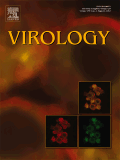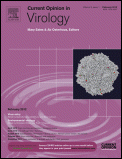
ARCHIVES OF VIROLOGY
Scope & Guideline
Pioneering insights into virology's challenges.
Introduction
Aims and Scopes
- Viral Pathogenesis and Immunology:
Research focusing on the mechanisms through which viruses cause disease, including host immune responses and viral evasion strategies. - Viral Epidemiology and Genomics:
Studies examining the spread of viruses in populations, genetic diversity, and phylogenetic relationships among viral strains. - Novel Virus Identification and Characterization:
Identification and genomic characterization of new viruses, including plant, animal, and human pathogens. - Viral Interactions with Hosts:
Research on how viruses interact with host cells, including entry mechanisms, replication processes, and the impact on host cellular functions. - Development of Diagnostic and Therapeutic Strategies:
Innovations in diagnostic methods and therapeutic interventions for viral infections, including vaccines and antiviral drugs. - Environmental and Ecological Virology:
Studies exploring the role of viruses in ecosystems, including their interactions with various hosts and their ecological impacts.
Trending and Emerging
- COVID-19 and SARS-CoV-2 Research:
A significant increase in studies related to SARS-CoV-2, including vaccine development, viral variants, and their impact on public health, reflecting the global pandemic's influence. - Viral Metagenomics and Environmental Virology:
Growing interest in the use of metagenomics to study viral diversity in various environments, including wildlife and agricultural settings, highlighting the ecological role of viruses. - Viral Host Interactions and Immune Evasion:
Research focusing on the intricate interactions between viruses and host immune systems, particularly mechanisms of immune evasion and adaptation. - Emerging Viral Diseases:
A heightened focus on newly identified viruses and zoonotic diseases, emphasizing the need for surveillance and understanding of viral spillover events. - Therapeutic and Preventive Strategies:
Innovations in antiviral therapies, including the repurposing of existing drugs and novel vaccine platforms, are trending as critical areas of research.
Declining or Waning
- Traditional Plant Virology:
Research specifically focused on classic plant viruses has seen a decrease, likely due to the increasing interest in viral interactions within complex ecosystems and the emergence of novel viruses. - Veterinary Virology:
Although still relevant, studies specifically addressing viral infections in livestock and pets seem to be receiving less attention compared to human and emerging infectious diseases. - Historical Virus Studies:
Research centered on historical epidemics and viruses that are less relevant today has diminished, as the focus shifts towards current and emerging viral threats.
Similar Journals

Advances in Virology
Exploring the Frontiers of Infectious DiseasesAdvances in Virology, an esteemed journal published by HINDAWI LTD, serves as a pivotal platform for cutting-edge research in the field of virology and infectious diseases. With its ISSN 1687-8639 and E-ISSN 1687-8647, the journal has been a significant contributor to the scientific community since its initiation as an Open Access resource in 2009, allowing researchers from around the globe to access groundbreaking findings without barriers. Operating out of the United States and recognized for its commitment to high-quality research, the journal's relevance is underscored by its ranking in the Q3 category for Infectious Diseases and Q4 for Virology as of 2023. The time frame of publications spans from 2009 to 2024, reflecting a continuous commitment to exploring the evolving landscape of virology. This journal not only promotes the dissemination of novel insights and methodologies but also fosters collaboration and innovation within the scientific community, making it an invaluable resource for researchers, professionals, and students alike.

Virology Journal
Fostering collaboration to combat viral challenges.Virology Journal, published by BMC, stands as a prominent open-access platform since 2004, dedicated to advancing the field of virology and infectious diseases. With its E-ISSN: 1743-422X, this journal is based in the United Kingdom and strives to disseminate high-quality research that enhances our understanding of viral pathogens and their interactions with hosts. Recognized with a Q1 classification in the category of Infectious Diseases and a Q2 in Virology for 2023, Virology Journal holds significant standing in the academic community, ranking #82/344 in Medicine - Infectious Diseases and #26/80 in Immunology and Microbiology - Virology. Its commitment to open access ensures that cutting-edge research is freely available to researchers, professionals, and students worldwide, fostering collaboration and innovation in the fight against viral diseases. The journal aims to publish original research articles, reviews, and commentaries that will stimulate discourse and spark new ideas within the virology community.

Journal of Virus Eradication
Advancing the fight against viral threats.Welcome to the Journal of Virus Eradication, a premier publication dedicated to advancing the field of virology and infectious disease research. Published by MEDISCRIPT LTD, this journal provides a vital platform for sharing cutting-edge research findings in key areas including epidemiology, immunology, and public health. With an impressive classification of Q2 in Epidemiology and Infectious Diseases for 2023, this journal exemplifies a commitment to high-quality scholarship and impactful research. The Journal of Virus Eradication is instrumental in disseminating knowledge that tackles viral threats, contributing to global health initiatives aimed at virus containment and eradication. Researchers, professionals, and students alike will find this journal an invaluable resource, making significant contributions to the scientific community and society at large.

VIROLOGY
Pioneering Research in Virology and PathogenesisVirology, published by Academic Press Inc. Elsevier Science, is a prominent journal dedicated to advancing the knowledge and understanding of viral biology and pathogenesis since its inception in 1955. With a distinguished impact factor and recognized as a Q2 journal in the field of Virology for 2023, it ranks 38 out of 80 in the Scopus database for Immunology and Microbiology, placing it in the 53rd percentile among similar publications. This esteemed journal provides a platform for groundbreaking research, critical reviews, and comprehensive studies that contribute to our global understanding of viruses and their impact on health and disease. Although currently not an open-access journal, it remains accessible to a wide audience of researchers, professionals, and students who are keen to explore the latest advancements in virological research. The journal's scope encompasses a diverse range of topics, ensuring that it serves as an essential resource for anyone engaged in virology and related biomedical fields.

VIRUS RESEARCH
Connecting discoveries in virus biology and medicine.VIRUS RESEARCH is a leading journal dedicated to the field of virology, published by Elsevier, and has been a cornerstone for researchers, professionals, and students since its inception in 1984. With an impressive impact factor, the journal is highly regarded, holding a Q2 category ranking in both Cancer Research and Infectious Diseases, as well as in Virology for 2023. Based in the Netherlands, it publishes high-quality, peer-reviewed articles that explore the intricate relationships between viruses and their hosts, novel therapeutic strategies, and advancements in virus biology. Researchers will find that it ranks 49th in Medicine - Infectious Diseases and 19th in Immunology and Microbiology - Virology according to Scopus, signifying its significant contribution and relevance in the academic world. VIRUS RESEARCH facilitates a platform for sharing groundbreaking discoveries, forming a vital part of the global scientific community, making it an essential read for those involved in the study of viral pathogens and their implications in medicine and biochemistry.

Retrovirology
Connecting Global Researchers in Viral ScienceRetrovirology is a prominent open-access journal published by BMC since 2004, dedicated to the field of retroviral research. With a strong focus on advancing knowledge in both infectious diseases and virology, this interdisciplinary journal has achieved a commendable ranking of Q2 in its respective categories as of 2023, reflecting its significant contribution to the scientific community. Hosted in the United Kingdom, Retrovirology serves a global audience of researchers, professionals, and students, making vital research accessible to all without barriers. The journal's emphasis on high-quality peer-reviewed articles supports the dissemination of groundbreaking findings that could shape the future of virology and related fields. With an impressive Scopus ranking, including a percentile of 65th in Medicine: Infectious Diseases, it stands out as a valuable resource for those committed to understanding and combating viral diseases. Retrovirology continues to be an essential platform for innovative research, with its open-access model ensuring that transformational science reaches the widest possible audience.

Microbiology Spectrum
Leading the charge in microbiology and immunology research.Microbiology Spectrum is a prominent peer-reviewed journal published by the American Society for Microbiology, dedicated to advancing the field of microbiology through the dissemination of high-quality research. Since its inception in 2013 and continuing until 2024, the journal has established a strong presence in key domains such as microbiology, immunology, cell biology, and ecology, achieving impressive quartile rankings including Q1 in Infectious Diseases and Q1 in Immunology and Microbiology as of 2023. With an emphasis on open access to its scholarly content, Microbiology Spectrum aims to foster collaboration and knowledge sharing among researchers, professionals, and students alike. The journal's scope encompasses a diverse range of topics pertinent to the field, making it an essential resource for anyone involved in microbiological research and its applications. Researchers looking to publish their findings in a respected journal will find Microbiology Spectrum's robust impact factor and Scopus rankings serve as testament to its significance and influence within the academic community.

Current Opinion in Virology
Championing Comprehensive Reviews in VirologyCurrent Opinion in Virology, published by Elsevier Science Ltd, is a premier journal dedicated to advancing knowledge in the dynamic field of virology. Established as a respected source of comprehensive reviews and critical evaluations, this journal boasts an impressive impact factor and has achieved a distinguished Q1 category ranking for virology, signifying its pivotal role in the academic community. Serving researchers, professionals, and students alike, Current Opinion in Virology presents insightful contributions that delve into the latest developments, emerging trends, and pivotal challenges facing virology today. With its Scopus ranking placing it in the top 15% of its field, the journal provides unparalleled access to cutting-edge research that informs both basic and applied aspects of virology. Although not an open-access journal, it offers options for subscriptions that ensure accessibility to critical content. As the field continuously evolves, Current Opinion in Virology remains at the forefront, bridging the gap between research and clinical application, making it an essential resource for all in the virology community.

VIROLOGIE
Advancing the frontiers of virology research.VIROLOGIE is a prominent international journal dedicated to advancing the field of virology and infectious diseases, published by John Libbey Eurotext Ltd. Since its inception in 1997, this journal has provided a platform for researchers and professionals to disseminate their findings on various aspects of virology, including the pathogenesis, epidemiology, and treatment of viral infections. Despite its current ranking in Q4 for both Infectious Diseases and Virology categories, the journal remains a valuable resource for emerging research and novel insights. The ISSN for the journal is 1267-8694, and it is based in France. VIROLOGIE is committed to upholding rigorous academic standards and fosters an inclusive scholarly community, making it an essential read for those pursuing knowledge and advancements in the ever-evolving landscape of virology. While the journal does not currently offer open access options, it continues to contribute significantly to the global discourse on viral research through its diverse range of published studies.

JOURNAL OF CLINICAL VIROLOGY
Transforming Knowledge into Solutions for Viral ChallengesJournal of Clinical Virology, published by Elsevier, stands at the forefront of virology research, focusing on the clinical implications of viral diseases. With an impressive impact factor representative of its Q1 categorization in both Infectious Diseases and Virology, this journal is essential for researchers and healthcare professionals aiming to keep pace with evolving knowledge and treatments in virology. Since its inception in 1998, it has provided a vital platform for the dissemination of significant breakthroughs, now continuing through to 2024. The journal boasts competitive Scopus ranks, placing it in the 95th percentile for Infectious Diseases and the 91st percentile for Virology. Scholars can benefit from its selective Open Access options, promoting widespread access to cutting-edge research. With an ever-increasing demand for innovative solutions to viral infections, Journal of Clinical Virology remains dedicated to fostering advancements in the field, making it a key resource for anyone invested in virology and infectious disease management.